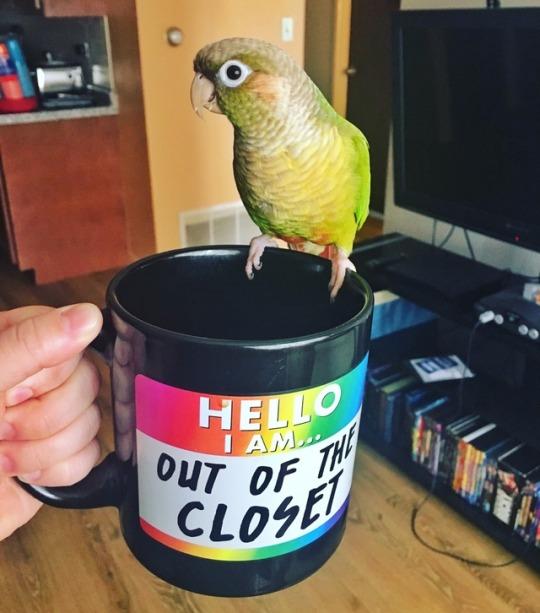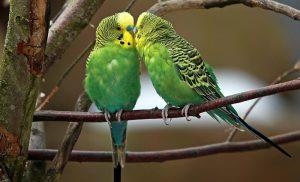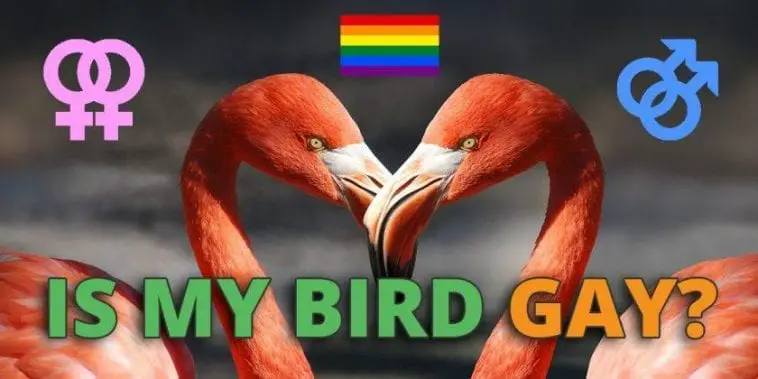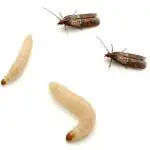Whether you own a Budgie, Parrot, Conure, or any pet bird, you surely did not want your little feathered bud to feel lonely, and so you decide to get another one to socialize and be friends with it (how I wish it would be that easy to find a partner!).
Birds are just like us humans; they yearn for love, belonging, and comfort in the wings of another. And one day, you might notice after some time that your birds are becoming more than just buddies, even if they are of the same sex! You are probably wondering if that is possible in the first place, how all of it happened, and what you need to do about the loveteam.
Do you let them be, or introduce them to other potential partners of the opposite sex? Well, there is no need to fear because you are not alone, and you have a guide to keeping your birdies flying high on the wings of love.

Yes, Birds Can Be Gay!
And that is completely normal. Just like us humans that may identify as lesbian, gay, bisexual, trans, or queer (LGBTQ), birds can also identify as homosexuals, minus the public “coming out” or annually organized Pride Flock.
In fact, same-sex couples in the animal kingdom are common, and plenty of them have shown to be gender-fluid, such as dolphins, koalas, and warthogs, and more. In the class of birds, there over a hundred species that demonstrate homosexual behavior. A gay bird is not spotted based off on their feathers or beaks; it will simply show up by as to which sex they prefer to be around more, although their physical features are a factor to be able to distinguish the males from females.

Same-Sex, Same Love
Male-to-Male and Female-to-female bird couples show their heart’s purest intentions to their better half just like straight couples. However, studies have shown that male pairs are more dominant in number compared to females as the ladies often tend to get aggressive and fight. The gay lovers would mutually feed, groom, kiss, neck, and mate.
They also practice nesting and are capable of raising offspring, even if these couples do not bear hatchlings together. What may seem “gay” or “homosexual” to us human beings is really just bonding for our feathered friends and is not new to their community either.
There’s even a children’s storybook about a gay penguin couple raising young together entitled, “A Tango Takes Three” and is based on penguins observed in real-life. In the wild, cozying up to the same-sex has also helped them survive by building alliances with other birds in order to gain the power to defend their territory or to look after the young. Hence, this trait is present too in their domestic brothers and sisters and has become an evolutionary adaptation. With a skill like this, birds take the dating scene to a whole new level through strategy!
Check out this clip of a couple of lovebirds canoodling right here:
Causes of Homosexuality and Choosing the Best for your Birds
While most are usually happy to see their queer birds in love, not all same-sex pairings tend to be sexual and are rather social. If their bond does bother you, however, you may try introducing your duo to other options, ahem… potential partners of the opposite sex.
So, what could be behind all of this? Since two birds are always together, they opt to bond with their only mate by default. Hence, they live in a limited environment, so meeting new folks might help turn things around. Nonetheless, this may not always work, and if you do not want to deal with the stress and responsibility of breeding, you might want to stick to your gay power couple.
Others might say that if you have a nesting box lying around, it might be encouraging this homosexual behavior, but Birdie is not exactly like Tweety, so this does not apply to all cases. Same-sex relationships among birds are also a result of not having any parental responsibility from the very start. This means for them that if there are no babies, they get to have more time on their feathers dedicated to bonding with each other. Plus, your birds could already be happy together, and keeping them apart would be devastating for the two, which may reflect on their diet and behavior once separated. So it is best to watch your birds have fun and grow in love.
Bruce Bagemihl: Animal Homosexuality
For homosexual birds, there’s documented evidence of transgender or homosexual behavior of the following kinds: affection, sex, pair bonding, courtship, or parenting. It was noted by author and researcher Bruce Bagemihl in his 1999 book entitled Biological Exuberance: Animal Homosexuality and Natural Diversity.

According to Bruce Bagemihl, there are different forms of animal sexual behavior. Even within the same animal species, the implications and motivations of their behaviors have to be fully understood. The research shows that such homosexual behavior has been documented in 500 species since 1999, which range from primates to worms in the gut.
Homosexuality in birds and other animals is seen as a very controversial topic by social conservatives. It because it asserts the natural homosexuality experienced by humans beings, while others counter it because it has no implications. They say that it’s nonsensical to compare animal behavior to human morality.
Animal motivation and preference are always shown in behavior. Homosexual behavior among animals has been given different terms over the years. When it comes to the correct usage of the homosexual, it pertains to an animal exhibiting homosexual behavior in terms of copulation, and sexual display behavior, mating games, and genital stimulation between two animals of the same sex.
Here’s a quick list of some examples of birds displaying homosexual behavior:
| Birds Adelie penguin American flamingo Anna’s hummingbird Aztec parakeet Bank swallow Bearded vulture Black-billed magpie Black-crowned night heron Black-rumped flame back Black swan Blue-crowned conure Blue-winged teal Budgerigar (domestic) Buff-breasted sandpiper | California Gull Canary-winged parakeet Caspian tern Chiloe wigeon Cliff swallow Common murre Crane spp. Egyptian goose Elegant parrot Eurasian oystercatcher European shag Gentoo penguin Golden bishop bird Gray-breasted jay Ruffed grouse Sage grouse | Grey heron Great cormorant Greater bird of paradise Greater rhea Green cheek conure Greenshank Griffon vulture Hammerhead (also known as hammerkop) Herring gull Hooded warbler House sparrow Ivory gull Roseate tern Rose-ringed parakeet Yellow-rumped cacique Zebra finch (domestic) |
| Jackdaw King penguin Laughing gull Lesser scaup duck Little blue heron Masked lovebird Mealy amazon parrot Mexican jay Mute swan Ocellated antbird Orange bishop bird Ornate lorikeet Wood duck | Ostrich Pied flycatcher Pied kingfisher Powerful owl Purple swamphen Raggiana’s bird of paradise Raven Red bishop bird Common redshank Regent bowerbird Ring dove Western gull White stor | Sand martin Scarlet ibis Scottish crossbill Seagull Senegal parrot Silver gull Silvery grebe Stitchbird Swallow-tailed manakin Tasmanian native hen Trumpeter swan Domesticated turkey Victoria’s riflebird |
Conclusion
Nothing could make you happier than seeing your own birds become actual lovebirds. As long as they stay happy and healthy, the couple is definitely in the hands of a great and proud owner. And you know what they say, there is no greater feeling than being in each other’s company”. Now let these same feathered lovers flock together!

